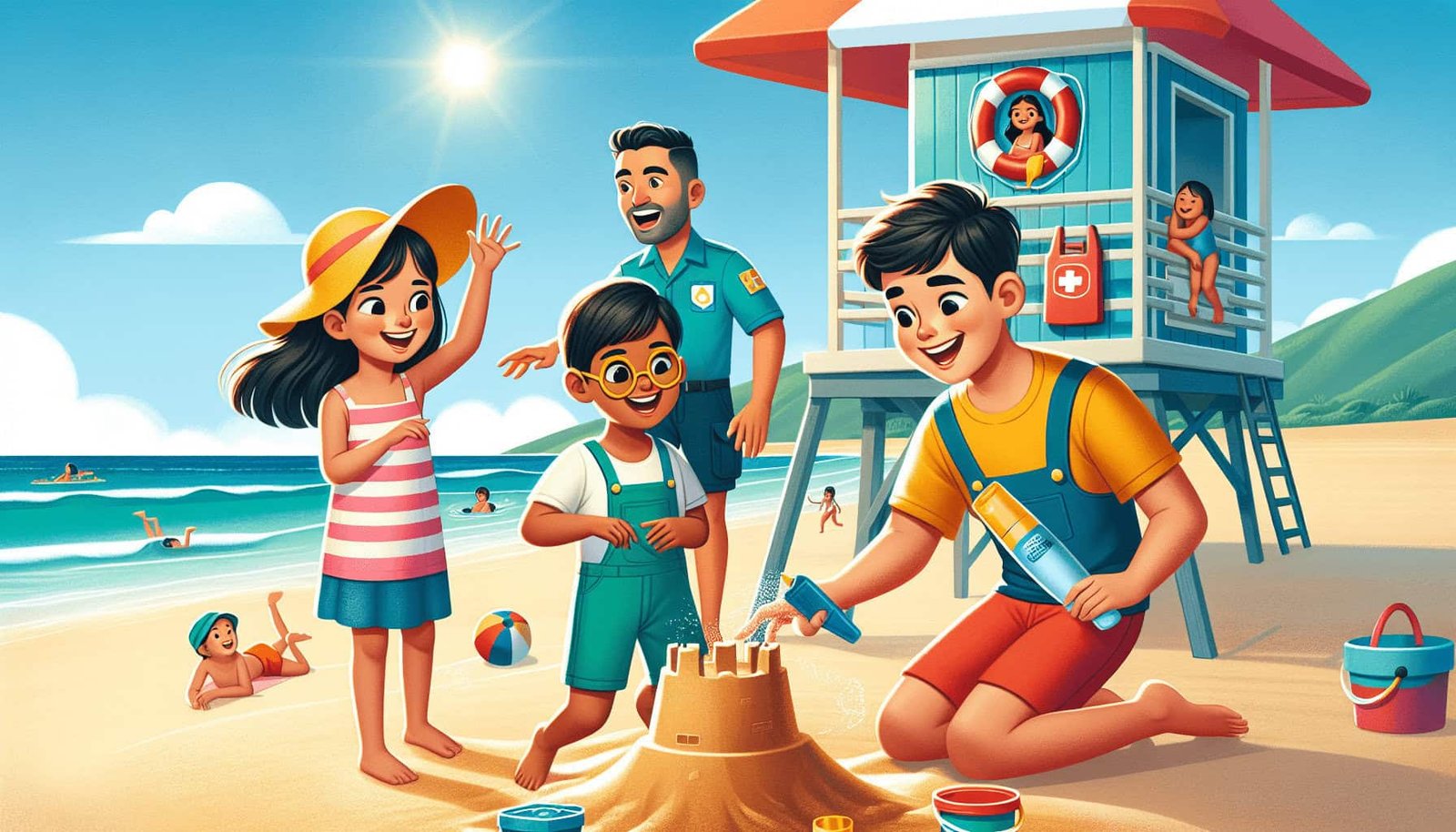Are you and your family planning a beach vacation soon? As a responsible parent, you want to ensure the safety of your children while they have fun in the sun and surf. Well, you’re in luck! There is a plethora of information available on beach safety specifically tailored for children and families. From tips on how to protect your little ones from harmful UV rays to expert advice on identifying and avoiding potential hazards, you’ll find everything you need to know to make your beach trip a safe and enjoyable experience for the whole family. So, sit back, relax, and allow me to guide you through the realm of beach safety for children and families.

Importance of Beach Safety
When it comes to spending time at the beach, safety should always be a top priority. Understanding the risks associated with beach activities, preventing accidents and injuries, and promoting water safety awareness are key to ensuring a fun and safe beach experience for everyone.
Understanding the risks
Before heading to the beach, it’s important to familiarize yourself with the potential risks involved. From strong currents and rip tides to drowning and jellyfish stings, being aware of these hazards can help you take necessary precautions to stay safe. By understanding the risks, you can better educate yourself and your loved ones on how to avoid dangerous situations.

Preventing accidents and injuries
Prevention is the best way to ensure a safe beach visit. By following some general beach safety guidelines, you can significantly reduce the risk of accidents and injuries. These guidelines include proper supervision and maintaining an appropriate adult-child ratio, sticking to designated swimming areas, wearing appropriate swimwear, using sunscreen and protective clothing, staying hydrated, and avoiding alcohol and drugs.
Promoting water safety awareness
Water safety is of utmost importance at the beach, especially for children and inexperienced swimmers. Teaching children to swim at an early age is crucial, as it helps build confidence and gives them the necessary skills to navigate the water safely. Additionally, it’s important to avoid strong currents and rip tides, recognize signs of drowning, use flotation devices and life jackets, practice the buddy system, and be knowledgeable about emergency rescues. By promoting water safety awareness, we can help prevent accidents and keep everyone safe in the water.

General Beach Safety Guidelines
To ensure the safety of everyone at the beach, it’s important to follow some general guidelines. Supervision is key, particularly when it comes to children. Maintaining an appropriate adult-child ratio ensures that children are always under watchful eyes. It’s also important to stick to designated swimming areas, as these areas are typically monitored by lifeguards and have been deemed safe for swimming.
Wearing appropriate swimwear is not only a matter of comfort, but it also helps with mobility in the water. Wearing a swimsuit instead of loose clothing reduces the risk of entanglement or drowning. Additionally, applying sunscreen and wearing protective clothing such as hats and sunglasses can help protect your skin from harmful UV rays.
Staying hydrated is essential, especially when spending long hours in the sun. Make sure to bring plenty of water and drink regularly to avoid dehydration. On the other hand, it’s crucial to avoid alcohol and drugs as they can impair judgment and increase the risk of accidents.
Water Safety Tips
When it comes to water safety, there are several key tips to keep in mind. Teaching children to swim from a young age is not only a valuable life skill but also helps build confidence in the water. It’s also important to avoid strong currents and rip tides. These powerful currents can quickly drag swimmers away from shore, making it difficult to return. If you find yourself caught in a current, it’s crucial to remain calm and swim parallel to the shore until you can escape its pull.
It is essential to recognize the signs of drowning, as drowning is often a silent event without splashing or yelling for help. Look out for individuals who are struggling to stay afloat, gasping for air, or having their head tilted back with their mouth open. If someone is in distress, it’s important to call for help and, if possible, throw a flotation device or reach out with a long object to assist them without putting yourself at risk.
Using flotation devices and life jackets can greatly enhance water safety, especially for non-swimmers and young children. These devices can provide an extra layer of protection and buoyancy in the water, allowing individuals to stay afloat more easily. It’s important to choose the right size and fit for each person to ensure maximum safety.
Practicing the buddy system is another essential water safety tip. Always swim with a partner and keep an eye on each other while in the water. This way, if one person encounters any trouble, the other can provide immediate assistance or call for help.
Being knowledgeable about emergency rescues is vital in case of any water-related accidents. Knowing how to perform basic rescue techniques such as throwing a rescue buoy or performing CPR can make a significant difference in saving someone’s life. Consider taking a water safety or CPR course to enhance your skills and prepare for emergencies.

Sun Safety Measures
Protecting yourself from the sun’s harmful rays is crucial for your overall well-being when spending time at the beach. Here are some sun safety measures to keep in mind:
Applying and reapplying sunscreen is essential to protect your skin from sunburn and skin damage. Choose a broad-spectrum sunscreen with a high SPF and apply it at least 15 minutes before sun exposure. Remember to reapply every two hours or more frequently if you’re swimming or sweating.
Seeking shade during peak sun hours, typically between 10 a.m. and 4 p.m., can help minimize sun exposure. Find a beach umbrella, tree, or other shaded area to take breaks from the sun and reduce the risk of sunburn.
Wearing hats and sunglasses provides additional protection for your face, head, and eyes. Opt for wide-brimmed hats that shade your face, neck, and ears. Sunglasses with UV protection help protect your eyes from harmful UV rays.
Covering up with clothing, especially during prolonged sun exposure, can shield your skin from the sun. Lightweight, long-sleeved shirts and pants made from UPF-rated fabrics are highly recommended. Additionally, consider wearing rash guards or swim shirts to protect your skin while in the water.
Protecting sensitive areas such as your nose and ears is crucial when it comes to sun safety. Apply sunscreen to these areas and consider wearing a hat with a wide brim or using a visor to keep the sun’s rays at bay.
By following these sun safety measures, you can enjoy your time at the beach without compromising your skin’s health.
Sand Safety and Beach Hazards
While the beach is a place of relaxation and fun, it’s important to be aware of potential hazards associated with the sand and water. Here are some sand safety and beach hazard tips to keep in mind:
Being cautious of hot sand is crucial, especially during hot summer days. Sand can reach high temperatures, burning your feet and causing discomfort. When walking on the sand, try to stay in the shade or wear protective footwear, such as flip flops or water shoes, to prevent burns.
Avoiding debris and sharp objects is important to prevent injuries. Always scan the area where you plan to lay your towel or set up your beach chair to ensure there is no broken glass, sharp shells, or other hazardous materials present. Remember to dispose of trash properly and encourage others to do the same.
Recognizing and avoiding jellyfish is essential for your safety. Some jellyfish have tentacles that can sting and cause pain or, in rare cases, more severe allergic reactions. If you encounter a jellyfish, it’s best to give it a wide berth and inform a lifeguard if one is present.
Checking for beach advisories or warnings is crucial to stay informed about any potential dangers. Before heading to the beach, consult local authorities or beach websites for any current advisories, such as water pollution or dangerous marine life sightings. Following these advisories will help you make informed decisions about your beach visit.
Knowing the local beach rules is important to ensure compliance and safety. Each beach may have specific rules and regulations, such as no diving, no pets allowed, or designated swimming areas. Familiarize yourself with these rules and make sure to adhere to them for the safety of everyone involved.

Creating a Beach Safety Kit
To ensure you are prepared for any unforeseen circumstances, creating a beach safety kit is a wise idea. Here are some essential items to include in your kit:
First aid essentials such as adhesive bandages, antiseptic wipes, pain relievers, and any necessary medications can be crucial in treating minor injuries or ailments that may occur at the beach.
Emergency contact information should be easily accessible. Write down important phone numbers, such as local emergency services, your doctor’s information, and any emergency contacts. Keep this information in a waterproof container or bag.
A whistle or signaling device can be helpful in attracting attention in case of an emergency. If you find yourself in a distressing situation, blowing the whistle can alert nearby people or beach patrols to your situation.
Water bottles and snacks are essential for staying hydrated and fueled during your time at the beach. Pack enough water for everyone and choose snacks that are easy to eat and don’t require refrigeration.
Extra clothing and towels are useful in case someone gets wet or needs to change into dry clothes. Additionally, having extra towels can provide comfort and warmth if needed.
Sunscreen and lip balm with high SPF should always be readily available in your beach safety kit. These items are crucial for protecting your skin from harmful UV rays and preventing sunburn.
A beach umbrella or tent can provide shade and protection from the sun. Setting up a shaded area can provide relief from the heat and reduce the risk of sunburn and overheating.
By having a beach safety kit prepared and easily accessible, you can be better prepared for any unexpected situations or emergencies that may arise during your beach visit.
Educational Resources and Tools
In today’s digital age, there are numerous educational resources and tools available to help you enhance your beach safety knowledge and skills. Here are some valuable resources to consider:
Websites with beach safety guides provide comprehensive information on various aspects of beach safety. These guides often cover topics such as water safety, sun safety, and general beach safety guidelines. Consult reputable websites that focus on beach safety to access valuable information and tips.
Downloadable beach safety brochures are available from many organizations that promote water and beach safety. These brochures are usually packed with important information and can be easily printed and shared with others.
Mobile apps for water and sun safety can be highly beneficial for on-the-go access to safety information. Some apps offer features such as real-time weather updates, sun protection tips, and emergency contact information. Look for apps that are endorsed by reputable organizations or have good reviews from users.
Local beach safety programs and classes are often offered in communities near popular beach destinations. These programs provide hands-on training and education on topics such as CPR, first aid, and water safety. Check with your local recreation centers, lifeguard organizations, or community centers to find out about any available programs.
Utilizing these educational resources and tools can help you and your loved ones become more knowledgeable and prepared when it comes to beach safety.
Preparing for Beach Visits
To ensure a smooth and enjoyable beach visit, it’s important to do some preparation beforehand. Here are some tips to help you prepare:
Checking weather and tide conditions before heading to the beach is crucial. Inclement weather or strong tides can pose safety risks, so it’s important to choose a day when conditions are favorable. Consult reputable weather websites, apps, or local authorities for up-to-date information.
Choosing family-friendly beaches is important, especially when you have children or elderly family members. Look for beaches that offer lifeguard services, have designated swimming areas, and provide amenities such as restrooms and picnic areas. Reading reviews or asking for recommendations can help you find the perfect beach for your family’s needs.
Planning activities and entertainment in advance can make your beach visit more enjoyable. Consider bringing beach toys, games, or books to keep everyone entertained. You can also plan beach-friendly activities such as beach volleyball, sandcastle building, or snorkeling.
Packing essential beach items ensures that you have everything you need for a comfortable and safe beach visit. Some essential items include towels, sunscreen, beach chairs or blankets, a cooler with snacks and drinks, and any necessary medications or personal items. Make a checklist to ensure you don’t forget anything important.
Creating a family safety plan is crucial in case of any emergencies or unexpected situations. Discuss safety rules with your family members and define a meeting point in case you get separated. Teach your children what to do if they encounter a dangerous situation and explain the importance of following lifeguards’ instructions.
By preparing for your beach visit in advance, you can minimize potential risks and maximize the enjoyment of your time spent at the beach.
Beach Safety for Different Age Groups
Beach safety considerations may vary depending on the age group of individuals involved. Here are some age-specific tips to keep in mind:
Infants and toddlers:
For infants and toddlers, constant supervision is essential. They should always be within arm’s reach and never left unattended near the water. Consider using swim diapers and appropriate flotation devices designed for their age and weight.
Preschoolers and young children:
Preschoolers and young children still require close supervision when near the water. Provide them with age-appropriate swimming lessons and reinforce water safety rules. Encourage them to stay in designated swimming areas and always swim with a buddy.
Preteens and teenagers:
Preteens and teenagers should be encouraged to practice good judgment and be aware of potential risks. Remind them to avoid swimming alone or in remote areas. Teach them about the dangers of riptides and the importance of following lifeguards’ instructions.
Seniors and elderly family members:
Seniors and elderly family members may have specific health concerns that need to be taken into consideration. Make sure they are aware of their limitations and take necessary precautions. Have regular breaks in shaded areas to prevent overheating and dehydration, and assist them with mobility if needed.
Pregnant women:
Pregnant women should consult their healthcare provider before engaging in any beach activities. They should stay hydrated, avoid prolonged exposure to the sun, and take breaks in shaded areas. Wearing comfortable and supportive swimwear can help provide additional comfort.
By considering the unique needs and vulnerabilities of each age group, you can better ensure their safety and enjoyment at the beach.
Emergency Procedures and Reporting
Despite our best efforts, emergencies can still occur at the beach. Being prepared and knowledgeable about emergency procedures is crucial. Here are some key points to remember:
Recognizing and responding to emergencies promptly is vital. If you witness someone in distress or in need of help, call for assistance immediately. Time is of the essence when it comes to water-related emergencies.
CPR and first aid training can be life-saving skills in emergency situations. Consider taking a CPR and first aid course to learn how to respond effectively to cardiac arrest, drowning, or other injuries.
Contacting lifeguards or beach patrols should be your first step when encountering an emergency at a monitored beach. Lifeguards are trained professionals who can provide immediate assistance and initiate rescue operations if necessary.
Reporting unsafe conditions or incidents to the appropriate authorities is important for the overall safety of beachgoers. If you notice any hazards, dangerous behaviors, or incidents, inform the lifeguards or beach patrols, who can take appropriate action to address the situation.
By knowing how to respond to emergencies and actively reporting unsafe conditions or incidents, you can help ensure the safety of yourself and others at the beach.
In conclusion, beach safety is paramount for a fun and worry-free experience. Understanding the risks, following general beach safety guidelines, promoting water safety awareness, and taking necessary precautions can significantly reduce the chance of accidents and injuries. By being prepared, informed, and vigilant, you can enjoy the beach to the fullest while keeping yourself and your loved ones safe.